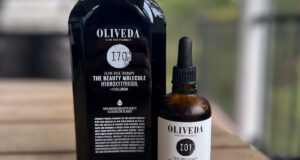It’s a muggy August evening in Portland, Oregon. Award-winning Haitian American chef Gregory Gourdet is closing up his restaurant, Kann, for the night. He’s scheduled to run his first leg (out of three) of the 2024 Hood to Coast relay marathon at 4 a.m. the next day.
The relay, also known as the “Mother of All Relays,” starts from the top of Mount Hood and ends on Oregon’s breezy Seaside Beach, which lies on the state’s Pacific coast. Because Mount Hood is a two-hour drive away, he must leave Portland by midnight at the latest.
After locking up Kann’s doors, he rushes home to pack a bag. He’s hoping that by the time he arrives at Mount Hood, he’ll have some spare moments to stretch and hype himself up before hitting the starting line.
Gourdet will be joining his six-person relay team, along with thousands of other folks from across the globe, to embark on this iconic race that spans 198 miles. The race is made up of 36 legs that are each around three to eight miles long. Teams must complete the course within 36 hours; the average finish time is 29 hours.
Gourdet Discovered His Joy for Running in the Throes of Addiction
It’s no secret that working in restaurants can be extremely stressful. The food service and hospitality industry has the highest rates of substance use disorder compared to all major employment sectors, according to a 2015 study by the Substance Abuse and Mental Health Services Administration.
In the early 2000s, Gourdet started working as a chef at high-profile restaurants. To cope with the pressure, he turned to alcohol and cocaine. His addiction to both quickly took a toll on his health. “I realized I needed to completely change my lifestyle, and I was very ready to do so,” Gourdet says.
He entered outpatient rehab in 2007 and got sober two years later. “I started running when I was in rehab because I really had nothing else to do,” Gourdet says.
What started as quick jogs transformed into 24-mile marathons. “Running allows me to spend a lot of time outside and clear my head,” he says.
In 2022, Gourdet fulfilled his lifelong dream of opening his own restaurant. Kann, which serves Haitian cuisine, won a James Beard award in 2023. Gourdet also runs a bar underneath Kann called Sousòl, which offers a wide variety of non-alcoholic drinks in addition to traditional wine and spirits.
The Meals (and Snacks) Gourdet Ate Before Race Day
The day before the race, Gourdet prioritized rest and filled up on nutrient-dense foods. Outside spoke with Gourdet to get a glimpse of his meal plan.
Quick-Fueling Fruits for Breakfast
“I wasn’t craving a lot of protein the day before the race, and I just wanted to make sure that I had enough fiber consumption prior, so I didn’t get all backed up,” says Gourdet. Fiber kickstarts muscle contractions in the gut, which helps food move smoothly through the digestive tract.
He opted for ripe peaches and sweet berries to prevent any pre-race constipation. On average, a peach contains a little over two grams of fiber, while a cup of mixed berries has nearly six. He packed a few more to snack on during breaks between relay legs.
Fruits are great because they’re full of complex carbohydrates, too, says Rhyan Geiger, a registered dietician and founder of Phoenix Vegan Dietitian. “They break down slower, so you can use that as fuel for your run.”
Although coffee is a morning staple for most, Gregory opted to skip it. Because the Hood to Coast race can take up to three days, the runners must find moments to snooze between legs in a sleeping bag on designated grounds or in their team’s van. “I avoided caffeine because I wanted to sleep as much as possible before and during the race,” he said.

A Sunflower Butter and Jelly Sandwich for Lunch
Gourdet stays booked and busy. Between running service at Kann, developing drink menus at Sousòl, writing cookbooks, and most recently launching a Haitian chocolate bar in partnership with Ranger Chocolate Co., the opportunity to sit down and enjoy a gourmet lunch, especially the day before a race, is rare.
So, he kept it simple: He lathered a few pieces of gluten-free seven-grain bread (untoasted) with sunflower butter and strawberry jelly.
Not only is this sandwich a protein powerhouse—two tablespoons of sunflower butter contains over seven grams of protein—but it’s also stacked with carbs, making it quite energizing. “Carbs break down into glucose, which is what we use for fuel,” says Geiger. “We can store it in our body as glycogen.”
Glycogen gets stored in your liver and muscles when you eat carbs; your body then uses this energy to power a workout. That feeling you get when you hit a wall and suddenly don’t have the strength to continue may be caused by not eating enough carbs, Geiger says.
Hydrating, Protein-Packed, and Salty Snacks
Gourdet didn’t shy away from snacking between meals. He savored bites of watermelon, creamy hummus, and salty potato chips.
“Eating watermelon can support hydration needs,” says Geiger. Runners can lose upwards of 1.5 quarts of water per hour, so saturating the body with liquids in advance helps.
Since sweating leads to a loss in sodium, says Geiger, salted chips can replenish lost nutrients because salt is made up of the electrolytes, sodium, and chloride, which help to usher nutrients to your cells and balance the water content in your body.
A batch of hummus made of legumes like chickpeas or black beans can help you meet your recovery needs, too, says Geiger. A half cup of hummus contains about eight grams of protein. If you run long distances, protein helps with repairing parts of your body, she says.
Hearty Curry for Dinner
For dinner, Gourdet decides to play it safe and chooses a meal he knows won’t mess with his digestion. He opts for a rich, creamy chicken curry dish garnished with veggies and ginger, plus a side of buttery coconut rice from his favorite local Burmese restaurant, Top Burmese.
Not only does this meal pack in all the macros needed to power through a race, but its warm, savory heartiness makes it feel like a comfort food. “I’m not afraid of spice; I love food filled with flavor, and my body can handle it really, really well,” he says.
Not everyone can handle lots of spice, though. “You can take ten marathon runners doing the same race, and their meals will look vastly different,” Geiger says. It’s important to listen to your body and lean on the foods that work for you, she emphasizes. You might realize mid-stride that too much spice doesn’t agree with you.
“The biggest thing I would say to athletes is don’t try something new before race day,” says Kristen Konkol, an associate teaching professor of exercise science at Syracuse University. You may experience digestive discomfort like stomachaches or sudden urges to use the bathroom if you experiment with foods that you’ve never eaten while training, she says.
Running Has a Special Place in Gourdet’s Life
“I loved [the relay] because historically staying up all night for me was never a healthy experience, but it was incredible to see thousands of folks running 24 hours a day for two days,” says Gourdet. During the race, he found that this relay demanded a high level of “mental organization,” which he thoroughly enjoyed.

“Running takes a lot of dedication,” says Gourdet. “You’re constantly checking in with yourself. Am I hungry? Am I thirsty? Does my back hurt? It offers a time to be there within your body, pushing yourself. And that feeling is extremely powerful.”




